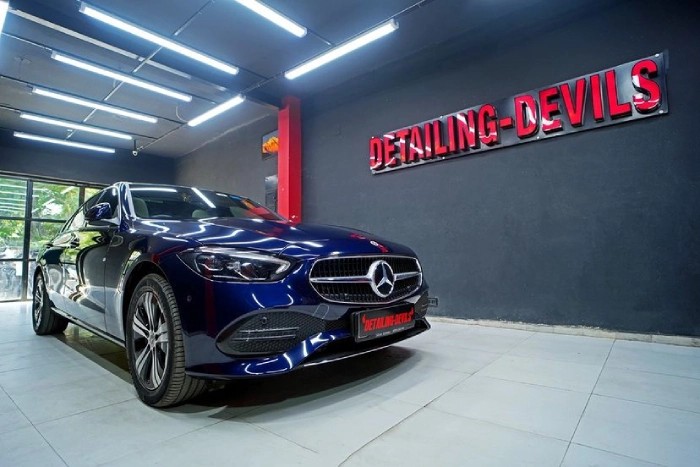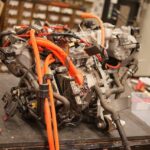Your car’s paint is more than just a color; it’s a shield against the elements and a key part of your vehicle’s value and appeal. From the daily commute to weekend adventures, your car’s paint faces a barrage of threats – scratches, road debris, harsh weather, and the relentless sun. That’s why investing in effective paint protection is a smart move for any car owner who wants to keep their vehicle looking its best for years to come.
Choosing the right paint protection can feel overwhelming with so many options available. Teflon coatings, ceramic coatings, and paint protection films (PPF) are often touted as top contenders, each promising superior defense against paint damage. But which one truly offers the Best Auto Paint Protection for your specific needs and budget?
This comprehensive guide breaks down the key differences between Teflon, ceramic, and PPF, providing expert insights to help you make an informed decision. We’ll delve into their protection levels, durability, costs, and maintenance requirements, empowering you to choose the ideal solution to safeguard your car’s finish and maintain its showroom shine.
 Teflon vs Ceramic
Teflon vs Ceramic
Alt text: Side-by-side comparison of Teflon, Ceramic, and Paint Protection Film (PPF) auto paint protection options, highlighting their varying levels of gloss and protection against scratches and environmental elements.
Exploring Different Types of Auto Paint Protection
The world of auto paint protection offers a range of solutions, each with distinct characteristics. Let’s examine three of the most popular types: Teflon coating, ceramic coating, and paint protection film (PPF).
Teflon Coating: The Budget-Friendly Barrier
Teflon coating, often referred to as polymer coating, utilizes polytetrafluoroethylene (PTFE) to create a protective layer on your car’s paint. Known for its non-stick properties, Teflon coating aims to repel water, dirt, and minor contaminants, making your car easier to wash and maintain.
Pros of Teflon Coating:
- Affordable: Teflon coating is generally the most budget-friendly paint protection option, making it accessible to a wide range of car owners.
- Easy Application: It’s relatively easy to apply compared to ceramic coating or PPF, sometimes even suitable for DIY application.
- Basic Protection: Offers a basic level of defense against dust, dirt, and water spots, enhancing the car’s gloss.
Cons of Teflon Coating:
- Limited Durability: Teflon coating is the least durable among the three options, typically lasting only a few months (around 3-6 months) before requiring reapplication.
- Minimal Scratch Resistance: It provides limited protection against scratches, swirl marks, or stone chips.
- Lower Protection Level: Less effective against harsh chemicals, UV rays, and environmental pollutants compared to ceramic coating or PPF.
Ceramic Coating: Advanced Chemical Resistance and Shine
Ceramic coating is a step up, employing a liquid polymer that chemically bonds with your car’s factory paint to create a durable, hydrophobic layer. This coating is significantly harder than Teflon and offers enhanced protection against a broader spectrum of threats.
Pros of Ceramic Coating:
- Superior Protection: Provides excellent resistance against UV rays, oxidation, bird droppings, acid rain, and minor scratches.
- Enhanced Gloss and Shine: Ceramic coating intensifies your car’s paint gloss, creating a deep, rich, and often admired “wet look.”
- Hydrophobic Properties: Its water-repelling nature makes washing easier, reduces water spots, and keeps your car cleaner for longer.
- Longer Lasting: Ceramic coatings typically last for several years (2-5 years), depending on the quality and number of layers applied.
Cons of Ceramic Coating:
- Higher Cost: Ceramic coating is more expensive than Teflon coating, requiring professional application for optimal results.
- Not Chip-Proof: While scratch-resistant, ceramic coating is not entirely resistant to heavy scratches or stone chips.
- Professional Application Recommended: Achieving the best results usually requires professional preparation and application to ensure proper bonding and longevity.
Paint Protection Film (PPF): Ultimate Physical Barrier
Paint Protection Film (PPF), also known as clear bra, is a transparent thermoplastic urethane film applied directly to the car’s paint. PPF is the most robust paint protection option, designed to shield your car from physical damage.
Pros of Paint Protection Film (PPF):
- Maximum Protection: Offers the highest level of protection against scratches, stone chips, swirl marks, road debris, and even minor dents.
- Self-Healing Properties: Many premium PPFs possess self-healing properties, allowing minor scratches and swirl marks to disappear with heat exposure.
- Longest Lifespan: PPF is the most durable option, often lasting for 5-10 years or even longer with proper care.
- Preserves Original Paint: PPF is virtually invisible and preserves the original look and color of your car’s paint.
Cons of Paint Protection Film (PPF):
- Highest Cost: PPF is the most expensive paint protection option due to material costs and the intricate professional installation required.
- Professional Installation Essential: PPF installation is complex and requires skilled technicians to ensure precise application without bubbles or imperfections.
- Can be More Noticeable Initially: While high-quality PPF is very clear, less expensive or poorly installed films can sometimes be noticeable, especially at edges.
Choosing the Right Auto Paint Protection for Your Needs
Selecting the best auto paint protection isn’t a one-size-fits-all decision. The ideal choice depends on your individual needs, budget, and driving conditions. Here are key factors to consider:
Protection Needs: What are you protecting against?
- Everyday Driving and Minor Scratches: If you’re primarily concerned about daily driving wear, minor scratches, and keeping your car clean, Teflon or ceramic coating might suffice.
- Harsh Weather and Environmental Elements: For areas with harsh weather, UV exposure, or environmental pollutants, ceramic coating offers superior chemical and UV resistance.
- Stone Chips and Road Debris: If you frequently drive on highways or roads with gravel or debris, PPF is the best line of defense against stone chips and significant paint damage.
Durability and Longevity: How long do you need protection?
- Short-Term Protection (under a year): Teflon coating can be a temporary solution for those on a tight budget or wanting basic protection for a short period.
- Medium-Term Protection (2-5 years): Ceramic coating provides several years of robust protection, making it a popular choice for long-term value.
- Long-Term Protection (5-10+ years): PPF offers the most extended protection, ideal for those who want to safeguard their car’s paint for the long haul and maintain its resale value.
Budget: How much are you willing to invest?
- Budget-Conscious: Teflon coating is the most affordable option for basic protection.
- Mid-Range Investment: Ceramic coating represents a balanced investment, offering excellent protection and longevity at a moderate price point.
- Premium Investment: PPF is a premium investment, providing the ultimate level of protection for those willing to pay for the best.
Maintenance: How much effort are you willing to put in?
- High Maintenance: Teflon coating requires frequent reapplication (every few months) to maintain its protective properties.
- Low Maintenance: Ceramic coating is low maintenance, generally requiring only regular washing with pH-neutral car soap.
- Very Low Maintenance: PPF is also very low maintenance, needing only regular washing to keep it clean and performing optimally.
Cost and Durability Comparison: At a Glance
To help you visualize the differences, here’s a comparative overview of cost and durability:
Cost Comparison:
| Type of Coating | Cost Range |
|---|---|
| Teflon Coating | $50 – $200 |
| Ceramic Coating | $500 – $2000 |
| Paint Protection Film (PPF) | $1,000 – $5,000 |
Durability Comparison:
| Type of Coating | Typical Lifespan |
|---|---|
| Teflon Coating | 3-6 Months |
| Ceramic Coating | 2-5 Years |
| Paint Protection Film (PPF) | 5-10+ Years |
Note: Costs are estimates and can vary based on vehicle size, product quality, and service provider.
Expert Tips for Choosing the Best Auto Paint Protection
Navigating the world of auto paint protection can be simplified with expert advice. Here are some key tips to guide your decision:
- Assess Your Driving Environment: Consider your typical driving conditions. Do you drive primarily in the city, on highways, or in areas with gravel or harsh weather? This will influence the level of protection you need.
- Consider Your Vehicle’s Value: For high-value vehicles or those you plan to keep for a long time, investing in ceramic coating or PPF can be a worthwhile investment to preserve their appearance and resale value.
- Read Reviews and Seek Recommendations: Research different brands and service providers. Read online reviews and ask for recommendations from trusted sources or other car enthusiasts.
- Consult with a Professional Detailer: A professional auto detailer can assess your specific needs, explain the pros and cons of each option in detail, and recommend the best auto paint protection solution for your vehicle and budget.
- Don’t Focus Solely on Price: While budget is important, prioritize value and long-term protection. A cheaper option that requires frequent reapplication might cost more in the long run than a more durable, albeit initially more expensive, solution.
Conclusion: Making the Informed Choice for Your Car’s Paint
Choosing the best auto paint protection ultimately comes down to understanding your individual needs and weighing the pros and cons of Teflon, ceramic coating, and paint protection film.
- For budget-conscious owners seeking basic, short-term protection and enhanced gloss, Teflon coating is an entry-level option.
- For those desiring long-lasting protection against environmental hazards, enhanced shine, and easier maintenance at a moderate price, ceramic coating is an excellent middle-ground choice.
- For car enthusiasts and owners seeking the ultimate defense against physical damage and long-term paint preservation, paint protection film (PPF) is the gold standard.
By carefully considering your driving habits, budget, and desired level of protection, you can confidently choose the paint protection solution that will keep your car looking its best for years to come, preserving its value and your pride in ownership.
Frequently Asked Questions (FAQs)
What is Teflon coating for cars?
Teflon coating for cars, also known as polymer coating, uses PTFE to create a slippery layer that repels water and dirt, offering basic protection against minor contaminants and enhancing gloss.
What is ceramic coating for cars?
Ceramic coating is a chemical sealant applied to a vehicle’s exterior to protect it from environmental damage, minor scratches, and oxidation. It provides a hard, glossy, and hydrophobic layer.
What is paint protection film (PPF) for cars?
Paint protection film (PPF) is a clear, polyurethane film applied to vehicle surfaces to protect the paint from scratches, chips, stains, and road debris, offering the highest level of physical protection.
Which type of auto paint protection is truly the best?
The “best” option depends on individual needs and priorities. PPF offers the highest level of protection, ceramic coating balances protection and cost, while Teflon is the most budget-friendly for basic needs. Consider your budget, driving conditions, and desired longevity to determine the best choice for you.
How much does professional auto paint protection cost?
Professional auto paint protection costs vary widely. Teflon coating can range from $50-$200, ceramic coating from $500-$2000, and PPF from $1000-$5000 or more, depending on vehicle size, coating quality, and installer.
See Also: Car Detailing Services Near Me
